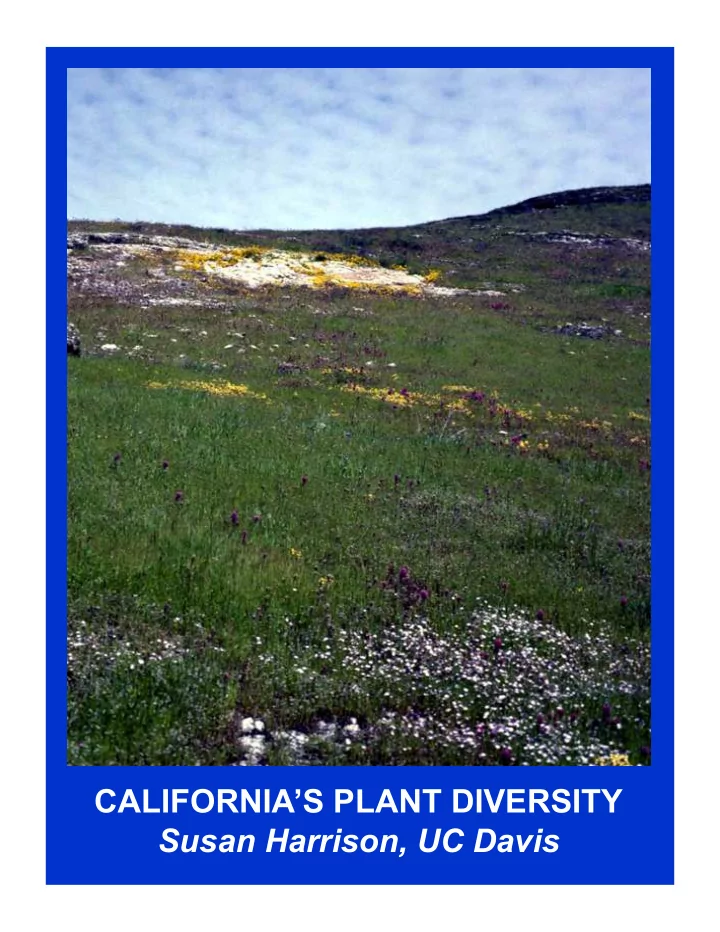

CALIFORNIA’S PLANT DIVERSITY Susan Harrison, UC Davis
WHAT IS DIVERSITY? • Many native species in a given site ( alpha ) or region ( gamma ) • Much variation in species from site to site within a region ( beta ) • Geographically restricted ( endemic ) species • Taxonomically distinctive species • What about California?
UNITED STATES “BIODIVERSITY HOTSPOTS” Stein et al., 1999
THE WORLD’S 25 BIODIVERSITY HOTSPOTS (Myers et al., 2000) • Definition: > 1500 endemic plant species. • Tropical Andes, Central America, Caribbean, Atlantic rainforest of Brazil, Madagascar, California Floristic Province… • 44% of all plant species and 35% of vertebrates in 4 groups. • 1/2 to 2/3 of plants and vertebrates on the IUCN Red List are hotspot endemics • Only 1.4% of earth's land surface!
CALIFORNIA....* • 4400 native species • 48% endemic • >20% rare or endangered • CA Floristic Province Roles of: climate, history, geology, topography, disturbance, invasions….
THE CALIFORNIA FLORISTIC PROVINCE
THE MEDITERRANEAN CLIMATE
THE WORLD’S MEDITERRANEAN CLIMATE REGIONS
DIVERSITY AND ENDEMISM IN MEDITERRANEAN REGIONS (from Dallman, 1998)
PLANT ADAPTATIONS IN MEDITERRANEAN CLIMATES Evergreen, sclerophyllous shrubs
Chaparral
PLANT ADAPTATIONS IN MEDITERRANEAN CLIMATES
Spring annuals
THE EVOLUTION OF CALIFORNIA’S MEDITERRANEAN FLORA
THE EVOLUTION OF CALIFORNIA’S MEDITERRANEAN FLORA
ORIGINS OF THE CALIFORNIA FLORA Raven & Axelrod 1978 • Northern elements “Arcto-Tertiary” 50% From warm wet temperate forests that were widespread 50 mya • Southern elements “Madro-Tertiary” 33% From semiarid habitats that developed about 20 mya • Desert elements 14% • California Floristic Province (CFP) endemics (% of species in the CFP belonging to genera or families of this origin; total = 4452 species)
Hotspots within California (Stebbins and Major 1964): Mt. St. Helena area, Santa Lucia Mts. “Intermediate” climate; topographic and geologic complexity All three major elements present
Role of geology and topography
Serpentine (ultramafic) rocks
Klamaths CALIFORNIA North Coast Sierra Nevada South Coast Napa, Lake, and Sonoma Counties
Serpentine (ultramafic) rocks and soils: <2% of California’s surface area, >10% of its endemic species Allium falcifolium (sickle-leaved onion) Serpentine mixed chaparral with leather oak and McNab’s cypress
‘The redrock forest may seem hellish to us, but it is a refuge to its flora... it is the obdurate physical adversity of things such as peridotite bedrock which often drives life to its most surprising transformations.’ - David Rains Wallace, The Klamath Knot (1983)
Role of fire in California’s Mediterranean vegetation
Sandstone chaparral 1 year post-fire
FIRE SPECIALISTS: Emmenanthe penduliflora Dicentra chrysantha
Serpentine chaparral 1 year post-fire
Streptanthus breweri : Calystegia collina : Calochortus amabilis :
Post-fire increase in local diversity: 45% in serpentine chaparral, 140% in sandstone chaparral Fire is less severe and less frequent in serpentine chaparral
INVASIONS 1,045 naturalized non-native species Around 10% threaten biodiversity Many/most are from the Mediterranean
Napa vegetation mapping project Partners: NatureServe, CDFG, Information Center for the Environment (UCD), regional stakeholders (BRBNA) For: local biodiversity hotspot analyses; conservation and planning decisions
Recommend
More recommend